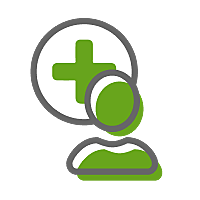Different types of acne and how to treat them

Medically reviewed by
Dr Kathryn BasfordLast reviewed: 22 Apr 2022
Acne is caused by a buildup of bacteria and excess oil in the pores of your skin. When your pores get clogged up, pimples and blemishes will form on the surface of your skin.
These pimples can range from simple blackheads to painful cysts depending on how clogged your pores are. Inflammatory acne, such as nodules and cysts, may need stronger treatment than superficial pimples. Depending on how widespread your pimples are, you may either have mild, moderate or severe acne.
All types of acne are treatable with the right medication and guidance.
Types of pimples
If you have acne, you might notice different types of pimples on your face. Most pimples are treatable with similar medications.
The hair follicles on your skin are connected to the sebaceous gland that produces an oil called sebum. Sebum is secreted through the pores on your skin and is needed to keep your skin supple and moisturised.
Pimples form when the pores of your skin become blocked by:
- a build up of bacteria or dead skin cells (debris) in your pores
- too much oil is that’s produced from the oil glands in your hair follicles
Bacteria live on your skin and are normally harmless. The “good” bacteria that live on our skin and other parts of our body help keep us safe from harmful infections.
Different triggers, like stress or medications, can lead to an overgrowth of this “good” bacteria. This can cause problems like acne, also known as acne vulgaris. Several different bacteria can contribute to acne but the most common one is Cutibacterium acnes. Antibiotic medication targets the overgrowth of this bacterium.
While the face is the most common area for acne to form, you can get acne anywhere on your body. This includes your back, shoulders and chest area.
If your pores are very clogged up, this can lead to inflammation and larger pimples forming. These pimples can cause scarring as the acne has gone deep into the layers of your skin. Acne scars can be craters in the skin, or discoloured skin.
Pimples like blackheads and whiteheads tend to be small and close to the surface. They can be treated with over the counter medication, or at a skin clinic where they can be extracted by a professional, such as a doctor that specialises in the skin (dermatologist).
In this section we’ll take a closer look at the different types of pimples:
- blackheads
- whiteheads
- papules
- pustules
- nodules
- cysts
Blackheads
Blackheads form when oil, bacteria or dead skin cells build up in your pores. The pore turns black when it comes into contact with the oxygen in the air. Blackheads are not filled with dirt and having blackheads might mean your skin is unclean. You should avoid scrubbing the blackheads as it can make the acne worse.
Blackheads are also known as open comedones. A comedone is a pore or hair follicle that is clogged up with bacteria, dirt or dead skin cells.
Whiteheads
Whiteheads form in a similar way to blackheads except the pore closes up, leaving a raised bump on your skin. Whiteheads are firm and flesh coloured and cannot be squeezed.
Whiteheads are also known as closed comedones. Both blackheads and whiteheads are non inflammatory pimples. This means that the acne has not progressed far enough to cause inflammation in the hair follicle, so they’re not red or painful.
Papules
Papules form when skin debris clog the hair follicle so much that it becomes swollen. The swelling leads to inflammation which gives papules their red colour. The hair follicle can also become infected if there is a build up of bacteria in the pores.
Pustules
Pustules form in a similar way to papules. Pustules have a white or yellow coloured tip surrounded by red skin. This tip is filled with pus, which is what your immune system releases when it tries to fight an infection. You might be tempted to squeeze a pustule to release the pus but this can cause long term scarring. It’s better to let the swelling go down by itself or use acne treatment to avoid acne scars like craters or patches of discoloured skin.
Nodules
Nodules occur when the inflammation gets deep underneath the skin’s surface. Nodules can be painful to touch and look like a raised bump. When healed, nodules often leave scarring on your face. If you have skin nodules, you’ll need specialist treatment from a dermatologist.
Cysts
Cysts are similar to nodules but are pus filled instead of solid. Cysts can be quite large and have a risk of causing permanent scarring to your skin. Cysts look a bit like boils and can be painful to touch.
Types of acne and how to treat them
When you are diagnosed with acne, you’ll likely have mild, moderate or severe acne. In some cases, people might have a combination of these types of acne.
The type of acne depends on what kind of pimples or lesions you have and how widespread they are. Whichever type of acne you have, you can be reassured that there are a lot of ways to help, with acne medication and advice from a doctor.
Most acne treatment regimens are used for 12 weeks (3 months), and during this time your doctor will review your progress. If your acne has cleared up in these 12 weeks you will not need to use any maintenance therapy to stop the acne from coming back.
Keep in mind that acne can take a few months to heal so it’s important to be patient with your skin.
In all types of acne, you can implement some skincare tips to help your skin recover. Try to avoid picking at your pimples or popping the spots, as tempting as it might be! Doing this can increase the chance of acne scars that can be permanent.
If you wear makeup, remember to remove it at the end of the day. It’s best to avoid using oil based products as this can make your acne worse. Remember that poor hygiene does not cause acne, so you can wash your face with water and a water based cleanser if you wish to. Try not to go overboard in cleaning your skin as this can irritate it.
If you are pregnant or breastfeeding, speak to your doctor before using any acne treatment.
from £59.00
from £19.50
from £24.00
from £34.50

No results found.
Please check your spelling or try another treatment name.
Mild acne
With mild acne, you'll mostly have blackheads and whiteheads. You may also have a few inflammatory pimples. Mild acne does not cause scarring and can often be treated with over the counter acne treatment that you can find at a pharmacy. Or a doctor can recommend prescription strength medicines.
Mild acne can be caused by hormonal changes. You may also have mild acne if you have a condition that causes you to have excess male sex hormones, such as polycystic ovaries syndrome (PCOS).
How to treat mild acne
If you have mild acne, you can get over the counter medication that contains salicylic acid from your local pharmacy to treat the acne. Your pharmacist will ask a few questions about your acne to make sure the medication is suitable for you.
To treat mild acne that does not respond to salicylic acid, a doctor might recommend:
- Differin cream
- Differin gel
- Epiduo gel
Differin cream and Differin gel both contain the active ingredient adapalene. Adapalene is an anti inflammatory medication. It works by preventing the formation of blackheads and whiteheads, and encouraging skin renewal. You can apply Differin once daily at night before you go to bed. You might want to choose Differin gel over the cream if your skin is more oily or sensitive, as the gel absorbs faster than cream.
Epiduo gel contains both adapalene and benzoyl peroxide. Benzoyl peroxide is an antibacterial medication that is specifically effective against Cutibacterium acnes. Benzoyl peroxide can also gently exfoliate the skin to get rid of dead skin cells. Epiduo gel is applied once a day, preferably in the evening.
Both Differin and Epiduo will get to work on your acne immediately, but you might not see any improvement until 3 to 4 weeks later. You can use either treatment for 12 weeks (3 months). If you do not see any improvement, speak to your doctor. They may recommend a different product.
Moderate acne
In moderate acne, you’ll have more papules and pustules on your skin than in mild acne. This increase in inflammatory pimples means you’ll need stronger acne treatment. You might notice your pimples are red and possibly painful to touch. There’s also a chance the pimples may scar once they have healed.
How to treat moderate acne
If you have moderate acne, you can use Differin gel or cream or Epiduo gel as well as additional treatment. Your doctor will advise you on the best combination of treatment to use.
There are several other lotions and creams you can use to treat moderate acne, including:
- Duac gel
- Aknemycin Plus
- Zineryt lotion
Duac gel contains benzoyl peroxide and clindamycin. Clindamycin is an antibiotic that will help clear up the overgrowth of the bacteria causing the acne.
Aknemycin Plus solution contains erythromycin, an antibiotic, and tretinoin. Another name for tretinoin is retinoic acid. This is a type of synthetic vitamin A. Vitamin A is important to keep your skin healthy. Tretinoin treats acne by speeding up your skin cell turnover. This means your skin gets rid of any dead cells quickly. By doing this, tretinoin opens up the clogged pores and makes it easier for the antibiotic in Aknemycin Plus to get to the bacteria in your pores.
Zineryt lotion contains erythromycin (antibiotic) and zinc. Zinc is useful in helping skin wounds to heal and makes it easier for erythromycin to be absorbed into the skin.
Sometimes your acne might improve with topical treatment (on the surface) but does not clear completely. In this case, your doctor may suggest taking oral antibiotics alongside using a cream or gel.
Severe acne
In severe acne, your skin will have a lot of inflammatory lesions, including pustules, papules, nodules and cysts. This can cause long term scarring on your face as the inflammation has progressed to the deeper layers of your skin.
To treat severe acne effectively, you’ll most likely need to take oral antibiotics while using a topical treatment at the same time.
How to treat severe acne
You can treat severe acne using the creams, gels or lotions used to treat mild or moderate acne.
Another alternative cream is called Skinoren, which contains azelaic acid. Azelaic acid stops testosterone from converting to dihydrotestosterone (DHT). An increase in DHT, a male sex hormone, can lead to increased acne. Azelaic acid can also act as an antimicrobial medication.
In addition to topical treatment, your doctor will prescribe oral antibiotics if you have severe acne. These treatments are part of the tetracycline family of antibiotics.
The main antibiotics used to treat severe acne are lymecycline and doxycycline. You should take 1 capsule every day in the evening. Your doctor will review your treatment progress after 12 weeks. You should never take only oral antibiotics to treat acne but use them in combination with a topical treatment.
If you are a woman, your doctor may suggest trying a combined contraceptive pill. Most combined contraceptive pills will help with acne symptoms, although some people can have acne as a side effect. Your doctor might recommend a specific type of pill, such as Dianette. Dianette is an oral contraceptive pill that is licensed to be used to treat acne. Dianette contains 2 active ingredients: cyproterone and ethinylestradiol. These are synthetic female sex hormones similar to the ones your body produces. Dianette works by blocking male sex hormone receptors and reducing their impact on your skin.
If your acne does not respond to several courses of antibiotics, your doctor may refer you to a specialist dermatologist. If suitable, you may be started on isotretinoin treatment, also known as Roaccutane. Isotretinoin is a specialist medication that has to be monitored by a dermatologist and cannot be taken by pregnant women or women who are trying for a baby.

Dr Kathryn Basford is a qualified GP who works as a GP in London, as well as with ZAVA. She graduated from the University of Manchester and completed her GP training through Whipps Cross Hospital in London.
Meet our doctorsLast reviewed: 22 Apr 2022
-
Acne, NHS [accessed March 2022]
-
Acne vulgaris, NICE/CKS [accessed March 2022]
-
How to treat different types of acne, American Academy of Dermatology [accessed March 2022]
-
Management of acne vulgaris in primary care, NICE/CKS[accessed March 2022]
-
Acne, NICE/BNF [accessed March 2022]




(Reviews are for ZAVA UK)


GMC: 7074021

GMC: 6149061

GMC: 7085115











